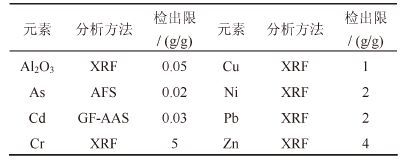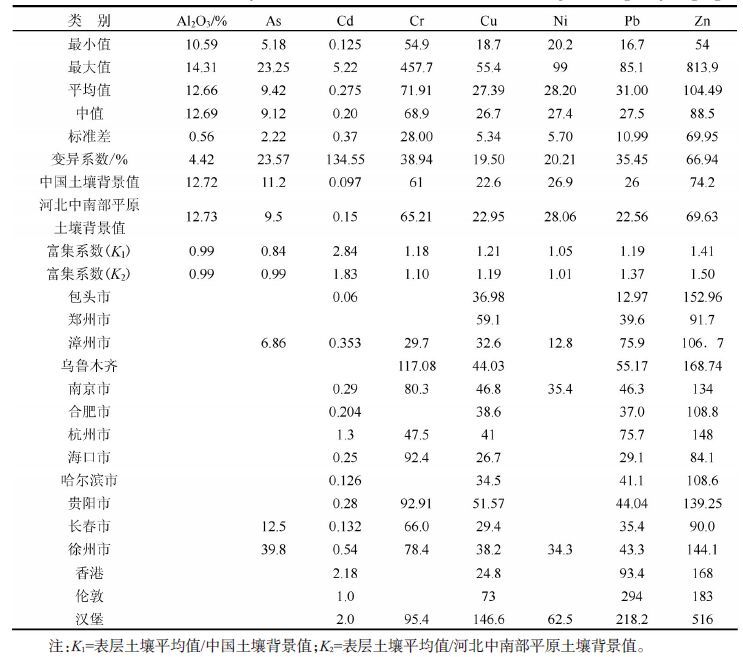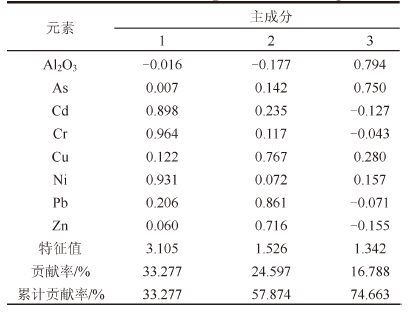城市土壤是指具有人为的、非农业作用形成的,由于土地的混合、填埋或污染形成的厚度大于或等于50 cm 的城区或郊区土壤[1]。在城市化进程中,城市土壤系统作为一种新型的生态环境污染研究系统正在不断的发展。城市土壤既是污染物的汇同时也是污染源,进入土壤的重金属元素不能降解,累积超过一定含量后可能对环境及生物产生毒害作用。由于城市土壤的重金属污染状况与城市人群的健康直接相关,近年来许多国家和地区开展了对城市土壤的大范围调查工作[2, 3, 4, 5, 6, 7, 8],中国有关城市土壤重金属分布及来源的研究报道也不断增加[9, 10, 11, 12, 13, 14, 15, 16, 17, 18, 19, 20, 21, 22, 23]。目前,元素来源研究的方法主要有元素形态分析法[24, 25]、剖面分析法[26]、空间分布分析法[27]、富集因子分析法[28]、地统计方法[29]等。综合运用这些方法可以比较直观地区别出人为来源与土壤母质残留的重金属。但是通过以上方法来辨别人为来源重金属进入土壤的具体途径,目前尚无更多报道。近年来多元统计分析方法(特别是主成分分析法、相关分析)作为辨识土壤中的重金属来源的经典方法,已经得到广泛的应用[30, 31, 32, 33, 34, 35, 36, 37],该方法与上述方法的综合运用,可以有效揭示土壤中重金属的主要来源。作为河北省省会城市,石家庄已具有多种工业类型,形成了包括医药、纺织、化工、机械、电子、食品、轻工、建材工业为主的工业经济体系,这些工业活动所产生的废物直接或间接进入了土壤,但有关石家庄市土壤重金属来源和累积程度的研究鲜有报道。本文在分析石家庄市土壤重金属含量的基础上,采用相关分析和主成分分析,对土壤重金属的来源和累积程度进行初步研究,实现土壤重金属空间分布的可视化表达,以期为研究区的土壤环境风险预警、管理和修复提供参考。
1 材料与方法 1.1 研究区概况石家庄市是河北省省会,是河北省政治、经济、科技、金融、文化和信息中心,是国务院批准的沿海开放政策和金融对外开放的城市。石家庄市是全国最大的医药工业基地和重要的纺织基地之一,是国家确认的首批生物产业基地,也是河北省的工业大市,基本形成以医药、纺织、化工、机械、电子、食品、轻工、建材工业为主的工业经济体系。
1.2 样品采集与分析本次研究以石家庄市主城区及其周边城乡结合带为研究区域,按照中国地质调查局多目标地球化学调查规范要求,采集表层土壤样品,采样密度为1 个样/km2,采样深度0~20 cm,共计220 个,采样示意图见图1。
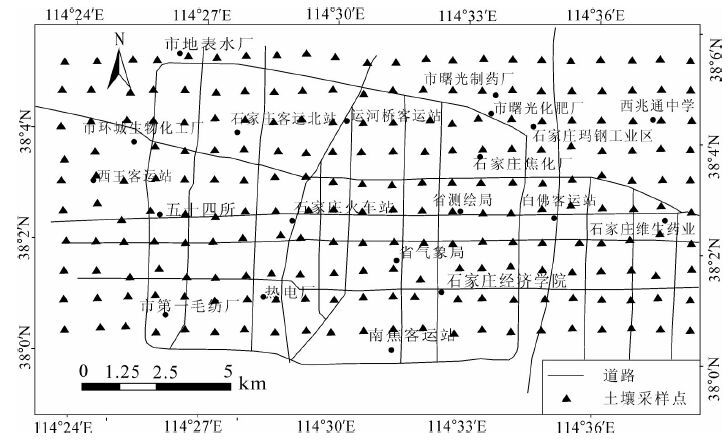
|
图1 石家庄城市土壤样点分布图 Fig.1 Distribution of the urban soil samples of Shijiazhuang City |
土壤样品采集1 kg左右,装在干净的布袋中贴好标签,进行自然风干。样品过筛前用木槌轻轻敲打,以便使土壤样品保持自然粒级状态。样品用尼龙筛,截取小于0.8 mm(20目)粒级组分500 g,装瓶。
所有样品分析在河北省岩矿测试中心实验室进行,采用以X 荧光光谱法(XRF) 为主,辅以原子荧光光谱法(AFS)和石墨炉原子吸收光谱法(GFAAS)的多元素配套分析方法,方法及检出限见表1,各元素报出率达100%。全部样品分析技术要求符合《生态地球化学评价样品分析技术要求》。
| 表1 土壤元素全量分析方法 Table 1 Analytical method of elements of the whole volume |
同时,分析过程中选用12 个土壤国家一级标准物质检验控制分析精密度和准确度,其结果符合表2的要求。
| 表2 分析方法准确度和精密度控制限 Table 2 Monitoring limits of accuracy and precision of the used analytical method |
本研究数据采用统计软件SPSS 17.0 进行处理,利用其分析模块中的描述统计功能、相关分析功能、因子分析功能分别对研究区土壤重金属元素进行特征统计分析、相关分析和主成分分析;图形制作主要采用ARCGIS 9.3 软件的空间分析模块对研究区土壤重金属元素的空间分布特征进行分析。
2 结果与讨论 2.1 土壤重金属元素含量特征由于土壤重金属污染的非均匀性,采用最小值、最大值、平均值、中值、标准差、变异系数和富集系数等7 个统计指标进行统计分析,研究区220 个表层土壤样品重金属含量测定结果见表3。
| 表3 石家庄城市土壤重金属含量(mg/kg)统计值 Table 3 Statistic values of heavy metal concentrations of urban soil of Shijiazhuang City(mg/kg) |
由表3 可见,Al2O3、As 的平均含量与中国土壤背景值和河北中南部平原土壤背景值都比较接近,其富集系数均小于1,变异系数也较小,其可能主要来源于土壤母质(自然来源)。
Cd、Cr、Cu、Ni、Pb、Zn 的含量范围较大,平均变异程度由大到小的顺序为:Cd>Zn>Cr>Pb>Ni>Cu,重金属含量变异系数大致呈现3 个层次,Cd、Zn两个元素的变异系数在50%以上,Pb、Cr、Ni 含量的变异系数在20%~40%,只有Cu 含量的变异系数小于20%,表明了在不同地点的Cd、Zn 含量有较大的差异,各采样点Cu含量分布比较集中。同时与不同的土壤背景值相比,这些元素含量显著偏高,呈现不同程度的富集,这与国内其他城市研究成果相同,基于不同土壤背景值的元素富集程度由高到低均为:Cd>Zn>Pb>Cu>Cr>Ni,均大于1,表明这些元素受到人为因素的影响,可能因为人为及工业活动而增加了土壤中的重金属含量。
2.2 元素相关性分析重金属元素之间的相关性可以有效地指示重金属的相同物质来源或迁移途径。从元素的相关性分析表明(表4),石家庄城市土壤中重金属元素含量相关系数可明显分为3 类:Cu与其他重金属元素之间都具有正相关关系,与Al2O3不存在相关关系,但其中与Pb、Zn的相关系数较大,表明它们可能具有相同的来源;Cd 元素除与As 不存在相关关系外,与其他重金属都存在显著相关关系,其中与Ni、Cr 的相关系数达到0.752 和0.869,这表明这些重金属可能具有相同的来源;Al2O3与As 元素存在正相关关系,表明As可能来源于自然源。
| 表4 石家庄市土壤元素相关系数 Table 4 Correlation matrix for the elements of heavy metals of urban soil of Shijiazhuang City |
因子分析方法能够很好地将元素按照相关性密切程度分类,从而通过各因子中的特征元素,判断该因子中的元素来源。该方法广泛运用于土壤或沉积物乃至大气沉降的元素来源的识别研究中。它能有效降低实测变量和揭示变量之间的相互关系。笔者对研究区220 个样点中的8 种元素进行主成分分析(Principal Component Analysis),因子矩阵经最大正交旋转后,得到大于1 的特征值3 个,其对应的主成分累积方差贡献率为74.663%。第一主成分是Cd、Cr、Ni ,贡献率为33.277%;第二主成分是Pb、Zn、Cu、,贡献率为24.597%;第三主成分是Al2O3与As,贡献率为16.788%;各元素的因子负荷分析结果如表5所示。
| 表5 对应3 个主成分因子的土壤重金属分析 Table 5 The results of principal component analysis and varimax rotated loading for the soil samples |
重金属元素在石家庄市土壤中的含量差别较大,其元素分布见图2。从图中可以看出,Cu、Pb、Zn 元素的空间分布相似,主要分布在城市的中东部、东北部和中西部、西北部,其高值区的分布与石家庄城市的工业区域分布及交通状况有关:石家庄中东部及东北部是石家庄重要的工业区所在地,区内分布着众多的工业企业如石家庄钢铁有限责任公司、石家庄焦化厂、石家庄热电三厂、石家庄水泥制品厂、石家庄化肥厂、石家庄煤机厂、石家庄内燃机配件厂、石家庄市曙光化肥厂、石家庄市曙光制药厂等,这些污染源会对石家庄市区土壤中的重金属含量造成一定的影响;同时,Cu、Pb、Zn 元素的高值分布区内分布着石家庄火车站、石家庄火车北站、白佛客运站、运河桥客运站、西王客运站等交通枢纽,高值区也主要分布在主要街道的交口位置,说明交通状况对石家庄市区土壤中的重金属含量造成一定的影响。Cr、Cd、Ni 元素都在市区的东北部形成高值区,这里是石家庄重要的工业区所在地。区内分布着石家庄钢铁有限责任公司、石家庄焦化厂、石家庄水泥制品厂、石家庄煤机厂、石家庄内燃机配件厂、石家庄市电焊机厂等,这些污染源会对石家庄市区土壤中的重金属含量造成一定的影响。As元素含量空间分布比较均匀,污染程度和富集程度普遍都在轻度污染和低富集。
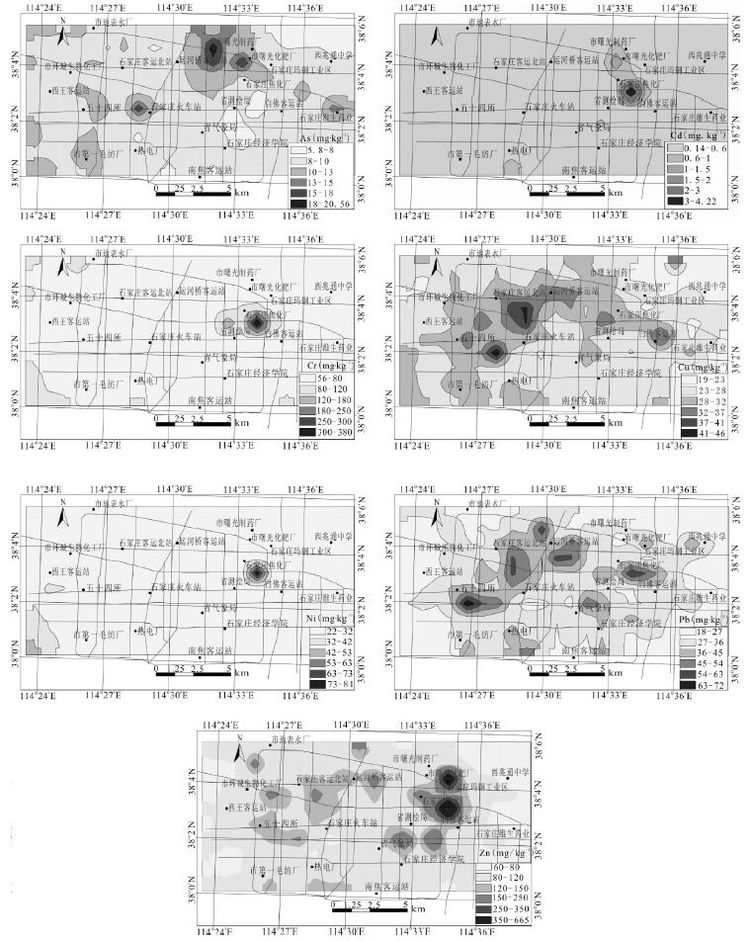
|
图2 石家庄城市土壤重金属分布图 Fig.2 Distribution of heavy metal concentrations of the urban soil of Shijiazhuang City |
土壤重金属来源既与基岩(或母质)本底有关,又受人类活动方式和强度的影响,所以可以分为自然源和人为源。通过以上相关分析表明,石家庄城市土壤中Cu、Pb、Zn、Cr、Ni、Cd与土壤背景值相比,它们都具有较高的含量和较大的富集因子。从元素含量的空间分布特征来看,Cu、Pb、Zn 元素的分布与工业区域分布和交通有关,Cr、Ni、Cd元素的分布与工业区域分布相吻合,表明这些元素与工业企业有关。相关分析表明,Cu、Pb、Zn 的相关系数较大,表明它们可能具有相同的来源,一般认为Pb 是汽车尾气排放的示踪元素[38],汽车轮胎磨损产生含Zn 粉尘,同时Zn 为冶金尘特征性较强元素[39],因此石家庄城市土壤中的Pb、Cu、Zn 与道路交通、工矿企业生产有关;Cd 与Ni、Cr 的相关系数较大,达到0.752 和0.869,这些重金属主要来自于冶炼、铸造、金属加工等工业污染源排放(海口市),同时,Ni 元素也为煤烟尘中特征较强元素[40, 41]。以上表明石家庄城市土壤中重金属元素主要来源于工业生产及燃煤;Al2O3与As 元素存在正相关关系,表明As 可能来源于自然源。主成分分析表明,Pb、Cu、Zn 元素组成一个主成分,Cd、Ni、Cr 元素组成一个主成分,这两个主成分都源于人为来源,主要受交通、工业和燃煤的影响。土壤中的Al2O3与As含量与背景值相近,具有较小的富集因子,主成分分析表明,它们具有相同的来源,主要来源于自然源,即来源于土壤母质。
石家庄城市大气降尘中Pb、Cr、As、Hg、Mo、Cd、Mn主要来源于燃煤活动、道路交通;Ni、Cu、Zn元素除与燃煤活动有关外,还与工矿企业废气排放有关;而Al2O3与K2O主要来源于研究区地面的土壤颗粒物[42],大气降尘中的重金属含量高值区与工业区域的分布相吻合。这与石家庄城市土壤重金属元素来源基本一致。
3 结论(1)研究区土壤样品重金属的平均含量分别为:As 为9.42 mg· kg-1、Cd 0.275 mg· kg-1、Cr 71.85mg· kg-1、Cu 27.39 mg· kg-1、Ni 28.20 mg· kg-1、Pb 31mg· kg-1、Zn 104.48 mg· kg-1、;Al2O3、As 的平均含量与土壤背景值比较接近,其富集系数均小于1,变异系数也较小;Cd、Cr、Cu、Ni、Pb、Zn 的含量范围较大,平均变异程度由大到小的顺序为:Cd>Zn>Cr>Pb>Ni>Cu,与土壤背景值相比,这些元素含量显著偏高,呈现不同程度的富集,其富集系数均大于1,表明这些元素受到人为因素的影响,可能因为人为及工业活动而增加了土壤中的重金属含量。
(2)相关性分析表明,Cu 与Pb、Zn 的相关系数较大,Cd 与Ni、Cr 的相关系数达到较大,表明这些元素可能具有相同的来源;;Al2O3与As 元素存在正相关关系,表明As可能来源于自然源。
(3)主成分分析表明,因子矩阵经最大正交旋转后,得到大于1 的特征值3 个,第一主成分是Cd、Cr、Ni ,贡献率为33.277%;第二主成分是Pb、Zn、Cu、,贡献率为24.597%;第三主成分是Al2O3与As,贡献率为16.788%。
(4)石家庄城市土壤与大气降尘重金属元素来源基本一致,二者含量高值区与工业区域、交通分布相吻合。石家庄城市土壤来源解析认为:Pb、Cu、Zn 主要来源于工业生产、汽车尾气排放;Ni、Cr、Cd元素除与工业企业生产有关外,还与燃煤活动有关;而Al2O3与As主要来源于研究区的土壤母质。
| [1] | 卢瑛, 龚子同. 城市土壤分类概述[ J]. 土壤通报, 1999, 30: 60-64. Lu Ying, Gong Zitong. Summary of urban soil classification[J]. Chinese Journal of Soil Science, 1999, 30: 60-64 (in Chinese with English abstract).(  1) 1) |
| [2] | Imperato M, Adamo P, Naimo D, Arienao M, et al. Spatial distribution of heavy metals in urban soils of Naples city (Italy) [J]. Environmental Pollution, 2003, 124(2): 247-256.( 1) 1) |
| [3] | Facchinelli A, Sacchi E, Mallen L. Multivariate statistical and GISbased approach to identify heavy mental sources in soils[J]. Environmental Pollution, 2001, 114(3): 313-324.( 1) 1) |
| [4] | Chen T, Zheng Y, Lei M, et al. Assessment of heavy metal pollution 688 中国地质2016年 in surface soils of urban parks in Beijing, China[J]. Chemosphere, 2005, 60: 542-551.( 1) 1) |
| [5] | Luo X S, Yu S, Li X D. Distribution, availability and sources of trace metals in different particle size fractions of urban soils in Hong Kong: Implications for assessing the risk to human health[J]. Environmental Pollution, 2011, 159: 1317-1326.( 1) 1) |
| [6] | Yalcin G M, Ilhan S. Multivariate analyses to determine the origin of potentially harmful heavy metals in beach and dune sediments from Kizkalesi coast (Mersin), Turkey[J]. Bulletin of Environmental Contamination and Toxicology, 2008, 81: 57-68.( 1) 1) |
| [7] | Inigo V, Andrades M, Alonso-Martirena J I, et al. Multivariate statistical and GIS-based approach for the identification of Mn and Ni concentrations and spatial variability in soils of a humid Mediterranean environment: La Rioja, Spain[J]. Water, Air and Soil Pollution, 2011, 222: 271-284.( 1) 1) |
| [8] | Odeh I O A, Onus A. Spatial analysis of soil salinity and soil structural stability in a semiarid region of New South Wales, Australia[J]. Environmental Management, 2008, 42: 265-278.( 1) 1) |
| [9] | 王贵, 王芳. 重工业城市土壤重金属含量分布特征及污染评价-以包头市为例[J]. 干旱区资源与环境, 2008, 22(8): 170-173. Wang Gui, Wang Fang. Heavy metal concentration and contamination evaluation for the soil of heavy industry city-A case study of Baotou[J]. Journal of A Rid Land Resources and Environment, 2008, 22(8): 170-173(in Chinese with English abstract).(  1) 1) |
| [10] | 古德宁, 李立平, 邢维芹, 等. 郑州市城市土壤重金属分布和土壤质量评价[J]. 土壤通报, 2009, 40(4): 921-925. Gu Dening, Li Liping, Xing Weiqin, et al. Distribution of heavy metals in urban soils of Zhengzhou City and soil quality assessment[J]. Chinese Journal of Soil Science, 2009, 40(4): 921-925 (in Chinese with English abstract).(  1) 1) |
| [11] | 段慧敏, 朱丽东, 李凤全, 等. 浙江省永康城市土壤重金属元素富集特征[J].土壤通报, 2012, 43(3): 956-961. Duan Huimin, Zhu Lidong, Li Fengquan, et al. Heavy metals' enrichment and their sources of urban soils in Yongkang[J]. Chinese Journal of Soil Science, 2012, 43(3): 956-961(in Chinese with English abstract).(  1) 1) |
| [12] | 乔胜英, 李望成, 何方, 等. 漳州市城市土壤重金属含量特征及控制因素[J]. 地球化学, 2005, 34(6): 635-642. Qiao Shengying, Li Wangcheng, He Fang, et al. Characteristics and controlling factors of heavy metal contents in urban soils in Zhangzhou city, Fujian Province[J]. Geochimica, 2005, 34(6): 635-642(in Chinese with English abstract).(  1) 1) |
| [13] | 刘玉燕, 刘敏, 刘浩峰. 乌鲁木齐城市土壤中重金属含量与影响机制探讨[J].干旱区地理, 2007, 30(4): 552-556. Liu Yuyan, Liu Min, Liu Haofeng. Heavy metal content and its influence mechanisms to urban soils at Urumqi City[J]. Arid Land Geography, 2007, 30(4): 552-556(in Chinese with English abstract).(  1) 1) |
| [14] | 黄顺生, 吴新民, 颜朝阳,等. 南京城市土壤重金属含量及空间分布特征[J]. 城市环境与城市生态, 2007, 20(2): 1-4. Huang Shunsheng, Wu Xinmin, Yan Chaoyang, et al. Heavy metal concentrations and their spatial distribution in urban soils of Nanjing[J]. Uuban Environment & Urban Ecology, 2007, 20(2):1-4(in Chinese with English abstract).(  1) 1) |
| [15] | 王雄军, 赖健清, 鲁艳红, 等. 基于因子分析法研究太原市土壤重金属污染的主要来源[J]. 生态环境, 2006, 17(2): 671-675. Wang Xiongjun, Lai Jianqing, Lu Yanhong, et al. Main source of soil heavy metal pollution based on factor analysis in Taiyuan [J]. Ecology and Environment, 2006, 17(2): 671-675 (in Chinese with English abstract).(  1) 1) |
| [16] | 李增福, 朱继业, 王腊春. 合肥市城市土壤重金属元素含量及空间分布特征[J]. 城市环境与城市生态, 2009, 22(3): 24-27. Li Zengfu, Zhu Jiye, Wang Lachun, et al. Heavy metal contents and their spatial distribution in urban soil of Hefei City [J]. Urban Environment & Urban Ecology, 2009, 22(3): 24-27(in Chinese with English abstract).(  1) 1) |
| [17] | 贾华清, 章明奎. 杭州市城市土壤重金属的积累和释放潜力及其空间分异[J]. 浙江大学学报(农业与生命科学版), 2007, 33 (6): 677-684. Jia Huaqing, Zhang Mingkui. Accumulation, release potential and spatial variation of heavy metals in urban soils of Hangzhou City[J]. Journal of Zhejiang University, 2007, 33(6): 677-684 (in Chinese with English abstract).(  1) 1) |
| [18] | 何玉生. 海口城市土壤重金属污染特征与生态风险评估[J]. 生态学杂志, 2014, 33(2): 421-428. He Yusheng. Pollution characteristics and ecological risk assessment of heavy metals in Haikou urban soils[J]. Chinese Journal of Ecology, 2014, 33(2): 421-428 (in Chinese with English abstract).(  1) 1) |
| [19] | 张久明, 迟凤琴, 宿庆瑞, 等. 哈尔滨市城市土壤重金属空间分布特征及相关分析[J]. 东北农业大学学报, 2010, 41(7): 56-61. Zhang Jiuming, Chi Fengqin, Su Qingrui, et al. Study on spatial variability of soil heavy metal in Harbin building area [J]. Journal of Northeast Agricultural University, 2010, 41(7): 56-61 (in Chinese with English abstract).(  1) 1) |
| [20] | 吕建树, 张祖陆, 刘洋, 等. 日照市土壤重金属来源解析及环境风险评价[J]. 地理学报, 2012, 67(7): 971-984. Lv Jianshu, Zhang Zulu, Liu Yang, et al. Sources identification and hazardous risk delineation of heavy metals contamination in Rizhao City[J]. Acta Geographica Sinica, 2012, 67(7): 971-984 (in Chinese with English abstract).(  1) 1) |
| [21] | 武永锋, 刘丛强, 涂成龙. 贵阳城市土壤重金属元素形态分析[J]. 矿物学报, 2008, 28(2): 177-180. Wu Yongfeng, Liu Congqiang, Tu Chenglong. Speciation of heavy metals in urban soil at Guiyang[J]. Acta Mineralogica Sinica, 2008, 28(2):177-180(in Chinese with English abstract). 第43卷第2 期崔邢涛等:石家庄城市土壤重金属空间分布特征及源解析689 中国地质, 2016, 43(2)(  1) 1) |
| [22] | 杨忠平, 卢文喜, 刘新荣, 等. 长春市城区土壤表层重金属污染来源解析[J]. 城市环境与城市生态, 2009, 22(5): 29-33. Yang Zhongping, Lu Wenxi, Liu Xinrong, et al. Sources identification of heavy metals in urban soil of Changchun based on principal component analysis[J]. Uuban Environment & Urban Ecology, 2009, 22(5): 29-33(in Chinese with English abstract).(  1) 1) |
| [23] | 王学松, 秦勇. 徐州城市表层土壤中重金属环境风险测度与源解析[J]. 地球化学, 2006,35(1): 88-94. Wang Xuesong, Qin Yong. Environmental risk and sources of heavy metals in Xuzhou urban topsoil[J]. Geochimica, 2006,35 (1): 88-94 (in Chinese with English abstract).(  1) 1) |
| [24] | 刘杰, 钟雪梅, 梁延鹏, 等. 电镀废水污染水稻田土壤中重金属的形态分析[J]. 农业环境科学学报, 2006, 25(2): 398-401. Liu Jie, Zhong Xuemei, Liang Yanpeng, et al. Fractionations of heavy metals in paddy soils contaminated by electroplating wastewater[J]. Journal of Agro-Environment Science,2006, 25(2): 398-401(in Chinese with English abstract).(  1) 1) |
| [25] | Chen W, Qian G R, Lim T T, et al.Speciation of heavy metals in surface sediments from Suzhou Creek [J]. Journal of Shanghai University, 2007, 11(4): 415-425.( 1) 1) |
| [26] | Tyler G. Vertical distribution of major, minor, and rare elements in a Haplic Podzol [J]. Geoderma, 2004, 119(3/4): 277-290.( 1) 1) |
| [27] | Hamlett J M, D A Miller, R L Day, et al. Statewide GIS-based ranking of watersheds for agricultural pollution [J]. Soil and Water Cons., 1992, 47(5): 399-404.( 1) 1) |
| [28] | 姬亚芹, 朱坦, 白志鹏, 等. 天津市土壤风沙尘元素的分布特征和来源研究[J]. 生态环境, 2005, 14(4): 518-522. Ji Yaqin, Zhu Tan, Bai Zhipeng, et al. Distribution characteristics and sources of the elements in soil dust[J]. Ecology and Environmental Sciences, 2005, 14(4): 518-522(in Chinese with English abstract).(  1) 1) |
| [29] | Lv J S, Liu Y, Zhang Z L, et al. Factorial kriging and stepwise regression approach to identify environmental factors influencing spatial multi-scale variability of heavy metals in soils[J]. Journal of Hazardous Materials, 2013, 261: 387-397.( 1) 1) |
| [30] | Slavkovic L, Skrbic B, Miljevic N, et al. Principal component analysis of trace elements in industrial soils[J]. Environmental Chemistry Letters, 2004, 2(2): 105-108.( 1) 1) |
| [31] | 王学松, 秦勇. 徐州城市表层土壤中重金属元素的富积特征与来源识别[J]. 中国矿业大学学报, 2006, 35(1): 84-88. Wang Xuesong, Qin Yong. Accumulation and identification of heavy metals in Xuzhou urban topsoil[J]. Journal of China University of Mining & Technology, 2006, 35(1):84-88(in Chinese with English abstract).(  1) 1) |
| [32] | Guo Guanghui, Wu Fengchang, Xie Fazhi, et al. Spatial distribution and pollution assessment of heavy metals in urban soils from southwest China [J]. Journal of Environmental Sciences, 2012, 24(3): 410-418.( 1) 1) |
| [33] | Zahida Karim, Bilal Aslam Qureshi, Majid Mumtaz, et al. Heavy metal content in urban soils as an indicator of anthropogenic and natural influences on landscape of Karachi-A multivariate spatiotemporal analysis[J]. Ecological Indicators, 2014, 42: 20-31.( 1) 1) |
| [34] | Ali Esmaeili, Farid Moore, Behnam Keshavarzi, et al. A geochemical survey of heavy metals in agricultural and background soils of the Isfahan in industrial zone, Iran[J]. Catena, 2014, 121: 88-98.( 1) 1) |
| [35] | Sun Chongyu, Liu Jingshuang, Wang Yang, et al. Multivariate and geostatistical analyses of the spatial distribution and sources of heavy metals in agricultural soil in Dehui, Northeast China [J]. Chemosphere, 2013, 92: 517-523.( 1) 1) |
| [36] | Boruvka L, Vacek O, Jehlicka J. Principal component analysis as a tool to indicate the origin of potentially toxic elements in soils [J]. Geoderma, 2005, 128(34) : 289-300.( 1) 1) |
| [37] | 戴彬, 吕建树, 战金成, 等. 山东省典型工业城市土壤重金属来源、空间分布及潜在生态风险评价[J]. 环境科学, 2015, 36(2): 507-515. Dai Bin, Lv Jianshu, Zhan Jincheng, et al. Assessment of sources, spatial distribution and ecological risk of heavy metals in soils in a typical industry based city of Shandong Province, Eastern China[J]. Environmental Science, 2015, 36(2): 505-515(in Chinese with English abstract).(  1) 1) |
| [38] | Lewis J. Lead poisoning: a historical perspective[J]. EPA Journal, 1985, 11: 15-18.( 1) 1) |
| [39] | 汤奇峰, 杨忠芳, 张本仁, 等. 成都经济区As 等元素大气干湿沉降通量及来源研[J]. 地学前缘, 2007, 14(3): 213-222. Tang Qifeng, Yang Zhongfang, Zhang Benren,et al. A study of elements flux and sources from atmospheric bulk deposition in the Chendu[J]. Economic Region Earth Science Frontiers, 2007, 14(3): 213-222(in Chinese with English abstract).(  1) 1) |
| [40] | 李随民, 栾文楼, 宋泽峰, 等. 河北省南部平原区大气降尘来源及分布特征[J]. 中国地质, 2010, 37(6): 1769-1774. Li Suimin, Luan Wenlou, Song Zefeng, et al. The distribution and source of atmospheric dustfall in the southern plain of Hebei Province[J]. Geology in China, 2010, 37(6): 1769-1774 (in Chinese with English abstract).(  1) 1) |
| [41] | 宋泽峰, 栾文楼, 崔邢涛, 等. 冀东平原土壤重金属元素的来源分析[J]. 中国地质,2010, 37(5): 1530-1538. Song Zefeng, Luan Wenlou, Cui Xingtao, et al. An analysis of the sources of heavy metals in soils of eastern Hebei plain[J]. Geology in China, 2010, 37(5): 1530-1538 (in Chinese with English abstract).(  1) 1) |
| [42] | 崔邢涛, 栾文楼, 李随民, 等. 石家庄市大气降尘重金属元素来源分析[J]. 中国地质, 2012, 39(4): 1100-1115. Cui Xingtao, Luan Wenlou, Li Suimin, et al. An analysis of the sources of heavy metals in atmospheric dustfall in the Shijiazhuang city[J]. Geology in China, 2012, 39(4): 1100-1115 (in Chinese with English abstract).(  1) 1) |




